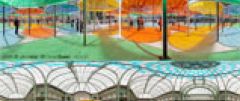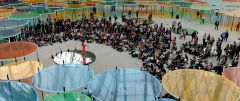© D.B. - ADAGP Paris
Viewpoints
How do we look at an art work? What about its environment? How does a work attract our attention? How does one place look at another place? What is there to be seen out of the window? Art history is full of many basic questions about viewpoints.
Instead of the single viewpoint that artists usually use, Daniel Buren offers multiple points of view, leaving the spectator free to choose his own perspective and change it at will. That is why the best way to approach his art is to walk around it, as each step brings a new vision of the work and the surrounding site.
Instead of the “one-eyed, unequivocal, dictatorial” viewpoint of paintings with the linear perspective of the Renaissance, Daniel Buren takes a different angle, for example, “real perspective” activated by a moving spectator. “There are no longer one or two viewpoints fixed in advance, but a multitude, without any hierarchy or order, which interact, interfere with and induce one another, in a process of mutual enrichment and contradiction. Each viewpoint has a meaning of its own, which does not annihilate the others.”
As when looking at Italian frescoes, Claude Monet’s Water Lilies or Kurt Schwitters’ Merzbau, the viewer orchestrates his own perception of the work and the site. His experience is unique, progressive and active (unlike the experience of looking at the great majority of paintings hung in museums, which must be seen from the front if anything is to be seen at all).
Moreover there is often virtual work to be done in synthesising several viewpoints: a plane to be imagined, lines to be linked up visually and mentally. In return for this freedom, the view we have of the work is always fragmentary, an idea which also interests Daniel Buren. The only way to gain an overall picture is by walking around, creating a dynamic sequence of personal views of the work itself and of its exterior, its context.








 Photo-souvenir : Sens dessus-dessous, sculpture in situ et en mouvement, permanente, Parc des Célestins, Lyon, novembre 1994. Détail.
Photo-souvenir : Sens dessus-dessous, sculpture in situ et en mouvement, permanente, Parc des Célestins, Lyon, novembre 1994. Détail.  Photo-souvenir : Sens dessus-dessous, sculpture in situ et en mouvement, permanente, Parc des Célestins, Lyon, novembre 1994. Détail.
Photo-souvenir : Sens dessus-dessous, sculpture in situ et en mouvement, permanente, Parc des Célestins, Lyon, novembre 1994. Détail.